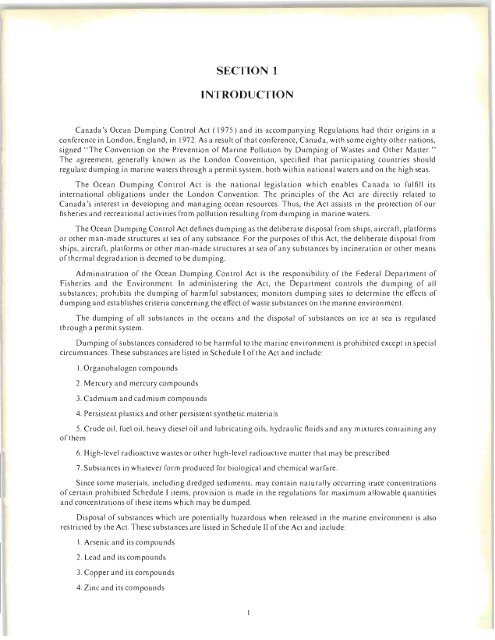You also want an ePaper? Increase the reach of your titles
YUMPU automatically turns print PDFs into web optimized ePapers that Google loves.
SECTION 1<br />
INTRODUCTION<br />
Canada 's Ocean Dumping Control Act ( 197 5) and its accompanying Regulations had their origins in a<br />
conference in London, Engl and, in 1972. As a result of that conference, Canada, with some eighty other nations,<br />
signed " The Convention on the Prevention of Marine Pollution by Dumping of Wastes and Other Matter."<br />
The agreement, generally known as the London Convention, specified that participating countries should<br />
regulate dumping in marine waters through a permit system, both within national waters and on the high seas.<br />
The Ocean Dumping Control Act is the nationa l legislation which ena bles Ca nada to fulfill its<br />
international obligations under the London Convention. The principles of the Act are directly related to<br />
Canada's interest in developing and managing ocean resources. Thus, the Act assists in the protection of our<br />
fisheries and recreational activities from pollution resulting from dumping in marine waters.<br />
The Ocean Dumping Control Act defines dumping as the deliberate disposal from ships, aircraft, platforms<br />
or other man-made structures at sea of any substance. For the purposes of this Act, the deliberate disposa l from<br />
ships, aircraft, platforms or other man-made structures at sea of any substances by incineration or other means<br />
of thermal degradation is deemed to be dumping.<br />
Administration of the Ocean Dumping Control Act is the responsibility of the Federal Department of<br />
Fisheries and the Environment. In administering the Act, the Department controls the dumping of all<br />
substances; prohibits the dumping of harmful substances; monitors dumping sites to determine the effects of<br />
dumping and esta blishes criteria concerning the effect of waste substances on the marine environment.<br />
The dumping of all substances in the oceans and the disposal of substances on ice at sea is regulated<br />
through a permit system.<br />
Dumping of substances consid ered to be harmful to the marine environment is prohibited except in special<br />
circumstances. These substances are listed in Schedule I of the Act and include:<br />
I. Organohalogen compounds<br />
2. Mercury and mercury compounds<br />
3. Cadmium and cadmium compounds<br />
4. Persistent plastics and other persistent synthetic materials<br />
5. Crude oil , fuel oil, heavy diesel oil and lubricating oils, hydraulic fluids and any mixtures containing any<br />
of them<br />
6. High-level radioactive wastes or other high-level radioactive ma tter that may be prescribed<br />
7. Substances in whatever form produced for biological and chemical warfare.<br />
Since some materials, including dredged sediments. may contain naturally occurring trace concentrations<br />
or certain prohibited Schedule I items, provision is made in the regulations for maximum allowable quantities<br />
and concentrations of these items which may be dumped.<br />
Disposal of substances which are potentially hazardous when released in the marine environment is also<br />
restricted by the Act. These substances are listed in Schedule II of the Act and include:<br />
I. Arsenic and its com pounds<br />
2. Lead and its compounds<br />
3. Copper and its compounds<br />
4. Zinc and its compounds

















